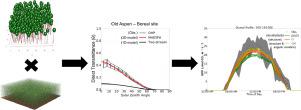当前位置:
X-MOL 学术
›
Agric. For. Meteorol.
›
论文详情
Our official English website, www.x-mol.net, welcomes your
feedback! (Note: you will need to create a separate account there.)
Influence of sun zenith angle on canopy clumping and the resulting impacts on photosynthesis
Agricultural and Forest Meteorology ( IF 5.6 ) Pub Date : 2020-09-01 , DOI: 10.1016/j.agrformet.2020.108065 Renato K. Braghiere , Tristan Quaife , Emily Black , Youngryel Ryu , Qi Chen , Martin G. De Kauwe , Dennis Baldocchi
Agricultural and Forest Meteorology ( IF 5.6 ) Pub Date : 2020-09-01 , DOI: 10.1016/j.agrformet.2020.108065 Renato K. Braghiere , Tristan Quaife , Emily Black , Youngryel Ryu , Qi Chen , Martin G. De Kauwe , Dennis Baldocchi

|
Abstract Addressing the impact of vegetation architecture on shortwave radiation transfer in land surface models is important for accurate weather forecasting, carbon budget estimates, and climate predictions. This paper investigates to what extent it is possible to retrieve structural parameters of two different parameterization schemes from direct transmittance derived from digital hemispherical photography and 3D radiative transfer modeling for two study sites with different vegetation canopy architectures. Neglecting the representation of 3D canopy structure in radiative transfer schemes leads to significant errors in shortwave radiation partitioning (up to 3.5 times more direct transmittance in the 3D model). Structural parameters, referred to as whole canopy ‘clumping indices’, were obtained in order to evaluate the impact of angular variation in clumping on shortwave radiation transfer. Impacts on photosynthesis were evaluated at site level with the UKESM land surface model, JULES. A comparison between flux tower derived and modeled photosynthesis indicates that considering zenith angular variations of structural parameters in the radiative transfer scheme of the UKESM land surface model significantly improves photosynthesis prediction in light limited ecosystems (from RMSE = 2.91 μmol CO2.m − 2.s − 1 to RMSE = 1.51 μmol CO2.m − 2.s − 1, 48% smaller), typically with enhanced photosynthesis from bottom layers.
中文翻译:

太阳天顶角对冠层丛生的影响及其对光合作用的影响
摘要 在地表模型中解决植被结构对短波辐射传输的影响对于准确的天气预报、碳预算估算和气候预测非常重要。本文研究了在多大程度上可以从具有不同植被冠层结构的两个研究地点的数字半球摄影和 3D 辐射传输模型得出的直接透射率中检索两种不同参数化方案的结构参数。忽略辐射传输方案中 3D 冠层结构的表示会导致短波辐射分区出现重大错误(3D 模型中直接透射率高达 3.5 倍)。结构参数,称为整个冠层“聚集指数”,为了评估成束中的角度变化对短波辐射传输的影响。使用 UKESM 地表模型 JULES 在场地水平评估对光合作用的影响。通量塔导出和模拟光合作用之间的比较表明,在 UKESM 地表模型的辐射传输方案中考虑结构参数的天顶角变化显着提高了光限制生态系统中的光合作用预测(来自 RMSE = 2.91 μmol CO2.m − 2.s − 1 到 RMSE = 1.51 μmol CO2.m − 2.s − 1,小 48%),通常具有增强的底层光合作用。
更新日期:2020-09-01
中文翻译:

太阳天顶角对冠层丛生的影响及其对光合作用的影响
摘要 在地表模型中解决植被结构对短波辐射传输的影响对于准确的天气预报、碳预算估算和气候预测非常重要。本文研究了在多大程度上可以从具有不同植被冠层结构的两个研究地点的数字半球摄影和 3D 辐射传输模型得出的直接透射率中检索两种不同参数化方案的结构参数。忽略辐射传输方案中 3D 冠层结构的表示会导致短波辐射分区出现重大错误(3D 模型中直接透射率高达 3.5 倍)。结构参数,称为整个冠层“聚集指数”,为了评估成束中的角度变化对短波辐射传输的影响。使用 UKESM 地表模型 JULES 在场地水平评估对光合作用的影响。通量塔导出和模拟光合作用之间的比较表明,在 UKESM 地表模型的辐射传输方案中考虑结构参数的天顶角变化显着提高了光限制生态系统中的光合作用预测(来自 RMSE = 2.91 μmol CO2.m − 2.s − 1 到 RMSE = 1.51 μmol CO2.m − 2.s − 1,小 48%),通常具有增强的底层光合作用。











































 京公网安备 11010802027423号
京公网安备 11010802027423号